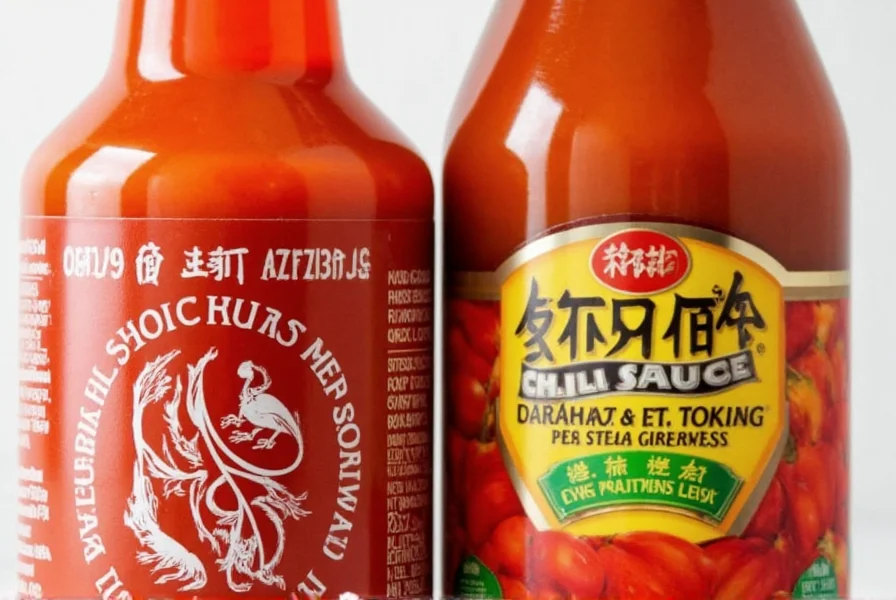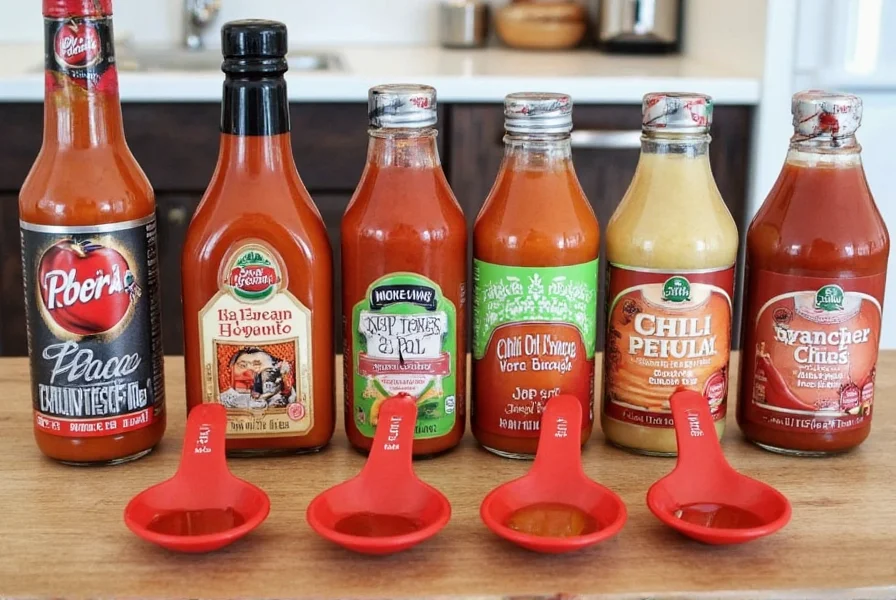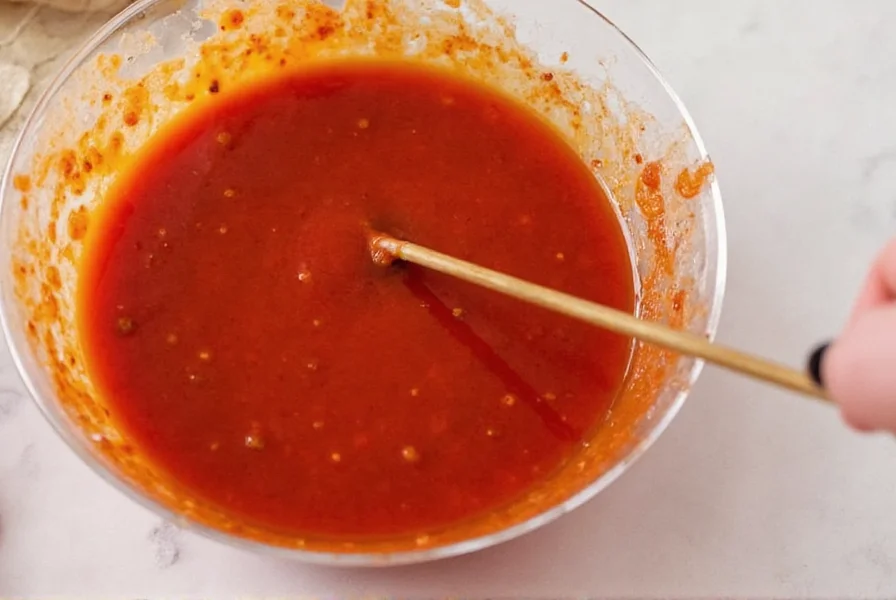When you find yourself without chili sauce but need to complete your recipe, understanding proper substitutions can save your dish while maintaining the intended flavor profile. Chili sauce brings a distinctive combination of sweetness, tanginess, and moderate heat to dishes, making it a staple in many Asian-inspired recipes, marinades, and dipping sauces. Whether you're dealing with an empty bottle, dietary restrictions, or simply want to experiment with different flavor profiles, knowing what to use instead of chili sauce ensures your cooking remains on track.
Chili sauce typically contains tomatoes, vinegar, garlic, sugar, and red chili peppers, creating a balanced flavor that's neither overwhelmingly spicy nor too mild. When seeking alternatives, consider which elements matter most for your specific dish—heat level, sweetness, acidity, or umami depth. This guide explores the most effective chili sauce replacements, complete with substitution ratios and usage recommendations for various cooking applications.
Top Substitutes for Chili Sauce
Understanding the nuances of each alternative helps you make informed decisions in the kitchen. The right substitute depends on whether you need to replicate the heat, sweetness, tanginess, or overall flavor complexity of traditional chili sauce.
Sriracha Sauce
Sriracha makes an excellent chili sauce substitute when you want similar heat with additional garlic notes. While chili sauce has a thicker consistency and more pronounced sweetness, sriracha offers a brighter, more vinegar-forward profile with visible garlic flecks. Use a 1:1 substitution ratio, but reduce additional sugar in your recipe by 1-2 teaspoons per tablespoon of sriracha to balance the flavors.
Sriracha works particularly well in stir-fries, noodle dishes, and as a dipping sauce where you want more pronounced garlic flavor. However, it lacks the tomato base of traditional chili sauce, so it won't provide the same rich color to dishes. For recipes where color matters, consider adding a small amount of tomato paste to sriracha to achieve a similar visual appearance.

Hot Sauce with Vinegar Base
Vinegar-based hot sauces like Frank's RedHot or Crystal Hot Sauce can effectively replace chili sauce when balanced with complementary ingredients. These sauces provide the necessary heat and acidity but lack the sweetness and body of traditional chili sauce. Create a balanced substitute by combining 2 parts hot sauce with 1 part ketchup or tomato paste and 1 teaspoon of sugar per tablespoon of mixture.
This combination works exceptionally well for recipes requiring chili sauce as a marinade component or in barbecue sauces. The vinegar content helps tenderize proteins while the added tomato element provides body. For dipping sauces, you may want to include a small amount of minced garlic and ginger to replicate the aromatic elements found in many commercial chili sauces.
Gochujang (Korean Red Pepper Paste)
Gochujang offers a complex fermented alternative to chili sauce with deeper umami notes and moderate heat. This thick, sticky paste contains glutinous rice, fermented soybeans, and red chili powder, creating a flavor profile that's simultaneously sweet, spicy, and savory. Substitute gochujang by thinning 1 tablespoon with 1-2 teaspoons of rice vinegar or water to achieve a consistency similar to chili sauce.
Gochujang shines in recipes where you want to add depth and complexity beyond simple heat. It works particularly well in Korean-inspired dishes, braises, and glazes. When using gochujang as a chili sauce replacement, reduce additional sugar in your recipe by half, as gochujang contains significant natural sweetness from the fermented rice. This substitute works best in dishes that can accommodate its distinctive fermented flavor profile.
| Substitute | Best For | Substitution Ratio | Flavor Notes |
|---|---|---|---|
| Sriracha | Stir-fries, dipping sauces | 1:1 (reduce sugar) | Garlicky, brighter heat |
| Hot Sauce Blend | Marinades, barbecue sauces | 2 hot sauce : 1 ketchup : 1 sugar | Vinegary, customizable heat |
| Gochujang | Braises, glazes, Korean dishes | 1 tbsp + 1-2 tsp liquid | Fermented, complex umami |
| Homemade Blend | All-purpose replacement | See recipe below | Most similar to commercial |
Homemade Chili Sauce Alternative
When you need a close approximation of commercial chili sauce, this simple homemade blend delivers consistent results. Combine ¼ cup tomato paste, 2 tablespoons rice vinegar, 1 tablespoon honey or brown sugar, 1 teaspoon minced garlic, ½ teaspoon red pepper flakes, and 2 tablespoons water in a small saucepan. Simmer gently for 5-7 minutes until flavors meld and sauce thickens slightly.
This versatile substitute works across most applications that call for chili sauce, from dipping sauces to stir-fry components. The beauty of making your own is the ability to adjust heat levels and sweetness to your exact preference. For a gluten-free version, ensure your vinegar is distilled rather than malt vinegar. This homemade alternative keeps well in the refrigerator for up to two weeks, making it practical to prepare in small batches when you run out of store-bought chili sauce.
Special Considerations for Substitutions
Certain dietary needs and recipe requirements call for specific substitution approaches. Understanding these nuances ensures your alternative works perfectly in context.
Gluten-Free Chili Sauce Replacement
Many commercial chili sauces contain wheat-derived ingredients or are processed in facilities with gluten. For those requiring gluten-free alternatives, sriracha (check label as most are gluten-free), pure hot sauces made with just peppers and vinegar, or the homemade blend described above provide safe options. Avoid soy sauce-based alternatives unless specifically labeled gluten-free, as traditional soy sauce contains wheat.
Low-Sugar Chili Sauce Alternatives
When reducing sugar content is necessary, replace chili sauce with a blend of tomato paste, vinegar, and a small amount of zero-calorie sweetener like stevia or erythritol. For every ¼ cup of chili sauce, use 3 tablespoons tomato paste, 1 tablespoon vinegar, ½ teaspoon sweetener, and 1 teaspoon water. This maintains the essential flavor components while significantly reducing sugar content.
Heat Level Adjustments
One of the most common reasons for seeking chili sauce alternatives is adjusting heat intensity. For milder dishes, replace chili sauce with a blend of ketchup, a small amount of paprika, and a touch of vinegar. For extra heat, incorporate a few drops of habanero sauce into your substitute mixture. Remember that heat perception varies by individual, so when cooking for others, it's wise to add heat gradually and allow diners to adjust to their preference at the table.

Practical Substitution Tips
Successfully replacing chili sauce requires more than just swapping ingredients—it involves understanding how the substitute interacts with other components in your recipe. Here are professional techniques to ensure your substitutions work seamlessly:
- Taste as you go: Always test your substitute mixture before adding it to your main dish, adjusting sweetness, acidity, or heat as needed
- Consider cooking time: Some substitutes like gochujang benefit from longer simmering to mellow flavors, while vinegar-based alternatives work best added toward the end of cooking
- Balance with complementary ingredients: When using a substitute that lacks certain elements (like sweetness in hot sauce), adjust other components in your recipe to maintain balance
- Texture matters: For recipes where chili sauce provides body (like glazes), ensure your substitute has similar viscosity by adjusting liquid content
Understanding these principles transforms simple ingredient substitution into thoughtful recipe adaptation. The goal isn't merely to replace chili sauce but to create a dish that satisfies your culinary intentions, whether that means preserving traditional flavors or intentionally evolving them with new ingredients.
Conclusion
Replacing chili sauce successfully depends on understanding both what you're missing from the original ingredient and what your specific recipe requires. The best substitute varies based on whether you need to replicate heat, sweetness, tanginess, or the complete flavor profile. By keeping sriracha, a vinegar-based hot sauce, or gochujang in your pantry, you'll always have options when chili sauce runs out. For the most authentic replacement, the homemade blend offers customizable heat and sweetness while avoiding preservatives found in commercial products.
Remember that cooking is as much about adaptation as it is about following recipes precisely. Each substitute brings its own character to dishes, potentially creating new favorite variations of familiar recipes. The next time you need to replace chili sauce, view it as an opportunity to explore flavor possibilities rather than a limitation.
Frequently Asked Questions
What's the best substitute for chili sauce in stir-fry?
The best substitute for chili sauce in stir-fry is a combination of sriracha and a small amount of ketchup or tomato paste. Use 1 tablespoon sriracha mixed with 1 teaspoon ketchup and ½ teaspoon sugar per tablespoon of chili sauce called for in your recipe. This maintains the necessary heat while replicating the sweetness and body that chili sauce provides to stir-fry sauces.
Can I use ketchup instead of chili sauce?
Yes, but with modifications. Plain ketchup lacks the heat of chili sauce, so you'll need to add heat elements. For each tablespoon of chili sauce, use 1 tablespoon ketchup plus ¼-½ teaspoon red pepper flakes or cayenne pepper, and ½ teaspoon vinegar to restore the tanginess. This combination works well in recipes where chili sauce is used as a base for barbecue sauces or sweet-and-spicy glazes.
Is there a non-spicy alternative to chili sauce?
Yes, for non-spicy applications, create a substitute using 2 tablespoons ketchup, 1 tablespoon tomato paste, 1 teaspoon vinegar, and ½ teaspoon sweet paprika per tablespoon of chili sauce needed. This provides the color and tanginess without the heat. For dishes requiring the umami depth of chili sauce without spice, add a small amount of soy sauce or Worcestershire sauce to this mixture.
How do I substitute chili garlic sauce for regular chili sauce?
Chili garlic sauce can directly replace chili sauce at a 1:1 ratio, but expect more pronounced garlic flavor and slightly different heat characteristics. Since chili garlic sauce typically contains visible garlic pieces and has a coarser texture, you may want to blend it briefly for recipes requiring smooth sauce. Reduce additional garlic in your recipe by half when making this substitution to avoid overpowering garlic notes.











 浙公网安备
33010002000092号
浙公网安备
33010002000092号 浙B2-20120091-4
浙B2-20120091-4